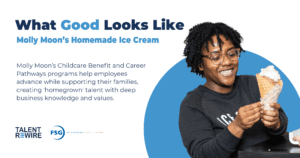Molly Moon’s Homemade Ice Cream
Main Challenge
Molly Moon’s aimed to retain and advance frontline employees, particularly working parents, by addressing barriers like limited career pathways and childcare challenges.
Opportunity Employment Practice
- Provide flexible childcare support through unrestricted vouchers, emergency care, or on-site services.
- Clearly communicate career advancement opportunities and salary growth, while holding managers accountable for regularly engaging in career development discussions with their team members.
Business Case
Career pathways programs and childcare benefits both improve retention and therefore lower turnover costs for companies by eliminating barriers to success in the workplace. Career pathways specifically support internal advancement, which leads to faster onboarding times, greater productivity, and lower hiring costs. Childcare benefits help to reduce unexpected call-outs for care related needs and family illness and help companies more efficiently staff for their needs. Childcare benefits also help promising leaders dedicate time to working on promotion-related tasks and be more available for management opportunities.
About What Good Looks Like
When companies empower their employees, everybody benefits. What Good Looks Like presents case studies of leading companies who have committed to supporting their frontline and entry-level employees. In a changing workforce landscape, it’s not only important but also urgent for employers to respond with innovation. Each edition of What Good Looks Like and each individual case study gives readers a closer look into how companies of diverse geographies and industries have piloted, implemented and scaled equitable talent practices.
We heard a consistent request from our employer partners for detailed examples of how other companies have made their visions of a more equitable, robust talent system a reality. We compiled What Good Looks Like to fill that request and added practical exercises on top of the research to help readers assess their own paths forward.
![]()
The research included in this case study was supported by funding from The James Irvine Foundation.

